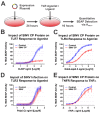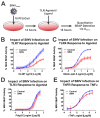The Alphaviral Capsid Protein Inhibits IRAK1-Dependent TLR Signaling
- PMID: 33673546
- PMCID: PMC7997285
- DOI: 10.3390/v13030377
The Alphaviral Capsid Protein Inhibits IRAK1-Dependent TLR Signaling
Abstract
Alphaviruses are arthropod-borne RNA viruses which can cause either mild to severe febrile arthritis which may persist for months, or encephalitis which can lead to death or lifelong cognitive impairments. The non-assembly molecular role(s), functions, and protein-protein interactions of the alphavirus capsid proteins have been largely overlooked. Here we detail the use of a BioID2 biotin ligase system to identify the protein-protein interactions of the Sindbis virus capsid protein. These efforts led to the discovery of a series of novel host-pathogen interactions, including the identification of an interaction between the alphaviral capsid protein and the host IRAK1 protein. Importantly, this capsid-IRAK1 interaction is conserved across multiple alphavirus species, including arthritogenic alphaviruses SINV, Ross River virus, and Chikungunya virus; and encephalitic alphaviruses Eastern Equine Encephalitis virus, and Venezuelan Equine Encephalitis virus. The impact of the capsid-IRAK1 interaction was evaluated using a robust set of cellular model systems, leading to the realization that the alphaviral capsid protein specifically inhibits IRAK1-dependent signaling. This inhibition represents a means by which alphaviruses may evade innate immune detection and activation prior to viral gene expression. Altogether, these data identify novel capsid protein-protein interactions, establish the capsid-IRAK1 interaction as a common alphavirus host-pathogen interface, and delineate the molecular consequences of the capsid-IRAK1 interaction on IRAK1-dependent signaling.
Keywords: IRAK1; alphavirus; capsid; toll like receptors (TLR).
Conflict of interest statement
The authors declare no conflict of interest. The funding agencies had no role in the study design, data collection and analysis, decision to publish, or the preparation of the manuscript.
Figures








Similar articles
-
The sticky business of Alphavirus capsid-host interactions.Trends Microbiol. 2025 Mar;33(3):321-339. doi: 10.1016/j.tim.2024.11.003. Epub 2024 Dec 10. Trends Microbiol. 2025. PMID: 39665907 Review.
-
Capsid protein mediated evasion of IRAK1-dependent signalling is essential to Sindbis virus neuroinvasion and virulence in mice.Emerg Microbes Infect. 2024 Dec;13(1):2300452. doi: 10.1080/22221751.2023.2300452. Epub 2024 Jan 7. Emerg Microbes Infect. 2024. PMID: 38164715 Free PMC article.
-
Comparative analyses of alphaviral RNA:Protein complexes reveals conserved host-pathogen interactions.PLoS One. 2020 Aug 25;15(8):e0238254. doi: 10.1371/journal.pone.0238254. eCollection 2020. PLoS One. 2020. PMID: 32841293 Free PMC article.
-
The Old World and New World alphaviruses use different virus-specific proteins for induction of transcriptional shutoff.J Virol. 2007 Mar;81(5):2472-84. doi: 10.1128/JVI.02073-06. Epub 2006 Nov 15. J Virol. 2007. PMID: 17108023 Free PMC article.
-
Venezuelan Equine Encephalitis Virus Capsid-The Clever Caper.Viruses. 2017 Sep 29;9(10):279. doi: 10.3390/v9100279. Viruses. 2017. PMID: 28961161 Free PMC article. Review.
Cited by
-
The sticky business of Alphavirus capsid-host interactions.Trends Microbiol. 2025 Mar;33(3):321-339. doi: 10.1016/j.tim.2024.11.003. Epub 2024 Dec 10. Trends Microbiol. 2025. PMID: 39665907 Review.
-
Binding of hnRNP I-vRNA Regulates Sindbis Virus Structural Protein Expression to Promote Particle Infectivity.Viruses. 2022 Jun 28;14(7):1423. doi: 10.3390/v14071423. Viruses. 2022. PMID: 35891402 Free PMC article.
-
The Host Non-Coding RNA Response to Alphavirus Infection.Viruses. 2023 Feb 18;15(2):562. doi: 10.3390/v15020562. Viruses. 2023. PMID: 36851776 Free PMC article. Review.
-
Unraveling the complex interplay: immunopathology and immune evasion strategies of alphaviruses with emphasis on neurological implications.Front Cell Infect Microbiol. 2024 Aug 15;14:1421571. doi: 10.3389/fcimb.2024.1421571. eCollection 2024. Front Cell Infect Microbiol. 2024. PMID: 39211797 Free PMC article. Review.
-
Chikungunya virus time course infection of human macrophages reveals intracellular signaling pathways relevant to repurposed therapeutics.PeerJ. 2022 Mar 21;10:e13090. doi: 10.7717/peerj.13090. eCollection 2022. PeerJ. 2022. PMID: 35341048 Free PMC article.
References
Publication types
MeSH terms
Substances
Grants and funding
LinkOut - more resources
Full Text Sources
Other Literature Sources
Molecular Biology Databases

